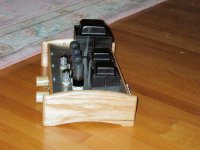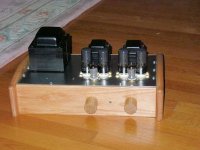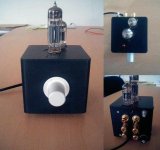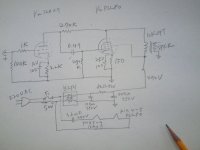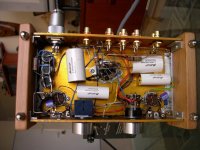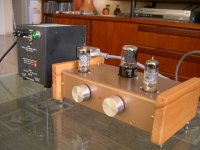Hi Stalker,
Both Lilliput and RH84 sound good.It all depends on your set up.A matter of taste too.
RH84 is a friendly amplifier. It sounds quite descent with any commercial speakers >85db. RH84 performs almost like my Audio Note P1SE amp.
Lilliput sounds excellent with horn loaded type speakers such as FOSTEX 206. It's more like a mini 300B. Frank or fdegrove claims more like Audio Note Baransu is quite true.Just got to try with Lowthers one day.Needs efficent speakers thoh.
regards,
zul
Both Lilliput and RH84 sound good.It all depends on your set up.A matter of taste too.
RH84 is a friendly amplifier. It sounds quite descent with any commercial speakers >85db. RH84 performs almost like my Audio Note P1SE amp.
Lilliput sounds excellent with horn loaded type speakers such as FOSTEX 206. It's more like a mini 300B. Frank or fdegrove claims more like Audio Note Baransu is quite true.Just got to try with Lowthers one day.Needs efficent speakers thoh.
regards,
zul
Nothing special..but
here it goes..It has two SE OPTs inside.I used partial feedback but just for fun. This makes sound and I am happy to show around to friends.
WANRING! do not use this right from the sound card of your PC. There may be some ground problem. A input transformer will solve this but..too bulky
here it goes..It has two SE OPTs inside.I used partial feedback but just for fun. This makes sound and I am happy to show around to friends.
WANRING! do not use this right from the sound card of your PC. There may be some ground problem. A input transformer will solve this but..too bulky
Attachments
Re: Killer amp
Did you build this to be a Christmas present for someone you wish to murder?
Yikes! You have the shield/ground sleeve of the RCA input jack wired directly to the 220 volt mains as well as the speaker output leads. I would suggest that the Amplifier Police raid your establishment pronto and supervise the destruction of that device. If that ever got into someone else's hands who didn't knoiw imagine what could happen., not to mention that you yourself could quite easily become it's victim also.
raid your establishment pronto and supervise the destruction of that device. If that ever got into someone else's hands who didn't knoiw imagine what could happen., not to mention that you yourself could quite easily become it's victim also.
Please, please Chul, put a mains isolation xfmer (or a power transformer of some sort) on this amp or destroy it.
Chul said:
WANRING! do not use this right from the sound card of your PC. There may be some ground problem. A input transformer will solve this but..too bulky
Did you build this to be a Christmas present for someone you wish to murder?

Yikes! You have the shield/ground sleeve of the RCA input jack wired directly to the 220 volt mains as well as the speaker output leads. I would suggest that the Amplifier Police
 raid your establishment pronto and supervise the destruction of that device. If that ever got into someone else's hands who didn't knoiw imagine what could happen., not to mention that you yourself could quite easily become it's victim also.
raid your establishment pronto and supervise the destruction of that device. If that ever got into someone else's hands who didn't knoiw imagine what could happen., not to mention that you yourself could quite easily become it's victim also.Please, please Chul, put a mains isolation xfmer (or a power transformer of some sort) on this amp or destroy it.

I agree. Let's avoid posting unisolated amps schematics.
Just for adding something mine, I just found a quartet of 220V/110V autotrasformers. Now I can hear what are you going to say, that those also are uninsulated...
...well I took my trusty multimeter and measured: no continuity between the 220V winding and the 110V one. So I build a voltage doubler ps, 2x1N4007, 2x470uF, 150ohm, 100uF and I'm extremely happy of the 320V that it makes
This is now powering a one-tube line stage, consisting in a ECC81 in cathode follower (one section for channel), into my Marantz 1060 power amp sockets. Well... beautiful sound!
What a pity I don't have a camera because you MUST see it... it's laid on a wooden board, very messy but very un-definitive
Just for adding something mine, I just found a quartet of 220V/110V autotrasformers. Now I can hear what are you going to say, that those also are uninsulated...
...well I took my trusty multimeter and measured: no continuity between the 220V winding and the 110V one. So I build a voltage doubler ps, 2x1N4007, 2x470uF, 150ohm, 100uF and I'm extremely happy of the 320V that it makes
This is now powering a one-tube line stage, consisting in a ECC81 in cathode follower (one section for channel), into my Marantz 1060 power amp sockets. Well... beautiful sound!
What a pity I don't have a camera because you MUST see it... it's laid on a wooden board, very messy but very un-definitive

Re: Re: Killer amp
Hi rcavictim,
Actually I tried more than 4 version of these direct rectifiction amps and I got to know how safe or dangerous this can be. Many old radios rectified the AC inlet direct because it is not connected to other component and have no groud problem. I just wanted to have some fun. And DIY is just about to have fun, right?
Just in case, I use this amp only in my office where designated circuit breaker is used. But I do not think this is as dangerous as 845 or 211. Signal or speaker ground is actually isolated not by the transformer but by the rectifiers. I heard the same from local DIYers here too.
Anyway thanks for the comments..
* I showed the circuit after a request, but to some novice this can be dangerous. But how do I delete the circuit? I have not done this before.

rcavictim said:
Did you build this to be a Christmas present for someone you wish to murder?
Yikes! You have the shield/ground sleeve of the RCA input jack wired directly to the 220 volt mains as well as the speaker output leads. I would suggest that the Amplifier Policeraid your establishment pronto and supervise the destruction of that device. If that ever got into someone else's hands who didn't knoiw imagine what could happen., not to mention that you yourself could quite easily become it's victim also.
Please, please Chul, put a mains isolation xfmer (or a power transformer of some sort) on this amp or destroy it.
Hi rcavictim,
Actually I tried more than 4 version of these direct rectifiction amps and I got to know how safe or dangerous this can be. Many old radios rectified the AC inlet direct because it is not connected to other component and have no groud problem. I just wanted to have some fun. And DIY is just about to have fun, right?
Just in case, I use this amp only in my office where designated circuit breaker is used. But I do not think this is as dangerous as 845 or 211. Signal or speaker ground is actually isolated not by the transformer but by the rectifiers. I heard the same from local DIYers here too.
Anyway thanks for the comments..
* I showed the circuit after a request, but to some novice this can be dangerous. But how do I delete the circuit? I have not done this before.
Giaime said:I agree. Let's avoid posting unisolated amps schematics.
I say let's not. They are hundreds opf postings on this board where schematics have been presented for member's evaluation. Many have potentially dangerous flaws which are spotted and ironed out by peer evaluation. That's the beauty of diyaudio.com and as a newbie that's where I have learned the most.
Goodness knows how many circuits here involve voltages that can & will kill you if handled incorrectly. I do not think we should start policing ourselves based merely on the premise that someone might do the wrong thing.
It seems that many of the Asian diyers are quite happy building equipment without isolation transformers. If so, more power (he he) to them, I am sure they are well aware of the risks & benefits involved.
Let's face it, with a few notable exceptions, most of what we discuss here would horrify the UL or whomever polices electronic equipment in your country.
PB
philipbarrett said:Let's face it, with a few notable exceptions, most of what we discuss here would horrify the UL or whomever polices electronic equipment in your country.
PB
Ehehehe, that's for sure!
heres my 50c5 guitar amp so far (yes I know its kinda messy.. ) :
The transformer board is how I step the wall voltage down and then back up. A bridge rectifier setup gives me between 130-140 volts. By changing the transformer leads I can get 240v.
An externally hosted image should be here but it was not working when we last tested it.
The transformer board is how I step the wall voltage down and then back up. A bridge rectifier setup gives me between 130-140 volts. By changing the transformer leads I can get 240v.
Re: Nothing special..but
Just put an input trafo and it'll get safe.Chul said:here it goes..It has two SE OPTs inside.I used partial feedback but just for fun. This makes sound and I am happy to show around to friends.
WANRING! do not use this right from the sound card of your PC. There may be some ground problem. A input transformer will solve this but..too bulky
6LU8, Sweep AMP
6LU8, Sweep AMP:
Some data and measurements:
2x12W rms, 2x25W peak
NFB: 14dB
16Hz-30kHz (-1dB)
THD: less than 1%, 12 watt output.
On the work bench:
Front side:
Final schematic:
Thanks to Birger, the flight mechanic that did the metal work.
6LU8, Sweep AMP:
Some data and measurements:
2x12W rms, 2x25W peak
NFB: 14dB
16Hz-30kHz (-1dB)
THD: less than 1%, 12 watt output.
On the work bench:
An externally hosted image should be here but it was not working when we last tested it.
Front side:
An externally hosted image should be here but it was not working when we last tested it.
Final schematic:
An externally hosted image should be here but it was not working when we last tested it.
Thanks to Birger, the flight mechanic that did the metal work.
- Home
- Amplifiers
- Tubes / Valves
- Photo Gallery
